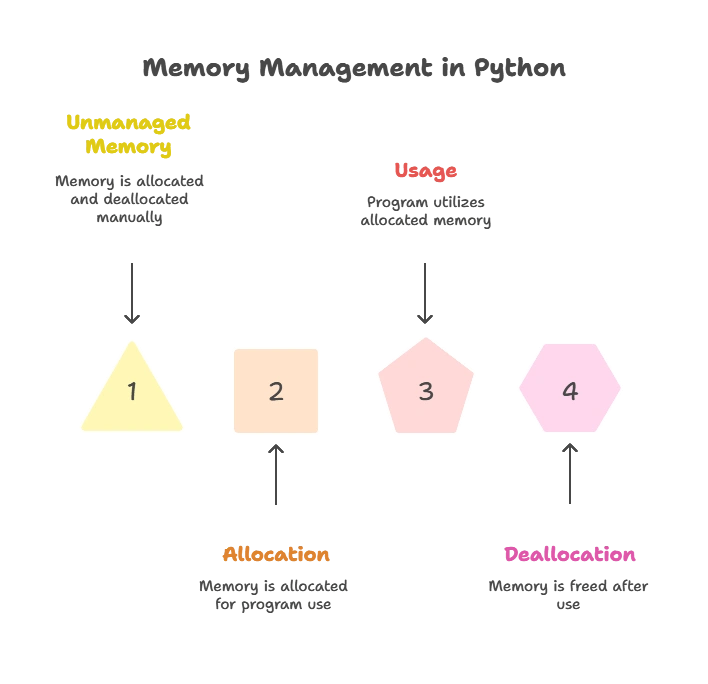Memory Management in Python (Garbage Collection)
Python, being a high-level programming language, abstracts many low-level operations, including memory management, from the developers. However, understanding how Python manages memory is crucial for writing efficient and bug-free code.
Introduction to Memory Management
What is Memory Management?
Memory management is the process of allocating and deallocating memory during the execution of a program. In Python, memory management is handled by the interpreter itself, abstracting the complexity from developers.
Why Memory Management Matters?
Efficient memory management ensures optimal usage of system resources and prevents memory leaks, which can degrade performance and lead to application crashes.

Basics of Memory Management
Object Creation and Memory Allocation
Every time you create an object in Python, memory is allocated to store its data.
x = 42 # Allocates memory for an integer object with value 42
Garbage Collection
Python’s Garbage Collector automatically reclaims memory occupied by objects that are no longer in use, ensuring efficient memory utilization.
Understanding Garbage Collection
Reference Counting
Python primarily uses reference counting to keep track of the number of references to an object. When the reference count drops to zero, the memory is deallocated.
x = 42
y = x # Two references to the same object
del x # Reference count of the object decreases by 1
Cycle-Detecting Garbage Collector
Python’s Garbage Collector also detects and collects objects involved in cyclic references, preventing memory leaks.
Working with Garbage Collection
Enabling and Disabling Garbage Collection
You can control the behavior of Python’s Garbage Collector using the gc module.
import gc
# Disable Garbage Collection
gc.disable()
# Enable Garbage Collection
gc.enable()
Manual Garbage Collection
You can manually trigger garbage collection using the gc.collect() function.
import gc
# Trigger Garbage Collection
gc.collect()
Memory Optimization Techniques
Avoiding Circular References
Circular references occur when objects reference each other, leading to memory leaks. Break circular references or use weak references to avoid them.
Using Generators and Iterators
Generators and iterators help in processing large datasets without loading the entire dataset into memory, thereby optimizing memory usage.
Advanced Concepts in Memory Management
Memory Profiling
Tools like memory_profiler can be used to profile memory usage and identify memory-intensive parts of the code.
Memory Leak Detection
Detecting memory leaks involves monitoring memory usage over time and identifying abnormal increases in memory consumption.
Complete Example :
Let’s demonstrate the concept of garbage collection with a simple example:
import gc
# Define a class
class MyClass:
def __init__(self):
print("Object created.")
# Create circular references
obj1 = MyClass()
obj2 = MyClass()
obj1.ref = obj2
obj2.ref = obj1
# Delete references
del obj1
del obj2
# Trigger garbage collection
gc.collect()
Output:
Object created.
Object created.
In this example, two objects of the class MyClass are created, and circular references are established between them. After deleting the references and triggering garbage collection, the objects are successfully deallocated, preventing memory leaks.
Memory management, particularly garbage collection, is a vital aspect of Python programming that directly impacts the performance and reliability of applications. Throughout this detailed exploration, we've covered the fundamentals of memory management, delving into the mechanisms of garbage collection, and exploring advanced techniques for optimizing memory usage. Happy coding! ❤️
